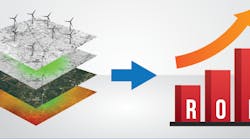We are in an interesting time in our industry; one we haven’t seen for the past 20 years. Esri has introduced new software to manage our utility networks within the core GIS (Geographic Information Systems) platform, GIS versioning has evolved from the ground up, and it may seem as though the entire market is playing “catch-up.”
Historically speaking, utilities have continually advanced their return on investment (ROI) in GIS technology, year over year, by adding new integration points to geo-enable other systems, adding new customizations to accelerate existing business processes, and using Web GIS to spatially engage new users throughout their organization. This has been the beauty of working in GIS. As the core Esri platform evolves, we are able to constantly add new value by expanding, extending, and integrating the technology.
In light of the advancing network management tools, the risk to utilities today is that we lose sight of advancing the ROI of our GIS while becoming solely focused on the new technology. There are fundamental changes coming in the core technology and you absolutely do NOT want to throw money away. No one will argue that point with you. The key to investing in GIS over the next three years is to make smart investments. That is obviously a generic statement so please allow me to elaborate.
Smart Investments for Your Systems Integration
This is the most significant area where you can easily add value today while maintaining a path forward with the new technology. The key is to design your integration in a way that will allow you to plug and play with the new Utility Network. How you do you this? There are many different ways to build an integration between GIS and another system (CIS, OMS, DPS, WMS, AMS, etc.).
Your risk goes up if you architect the integration using a point-to-point integration that depends on a direct link between the two systems. If you, however, use a services oriented architecture (SOA) integration, you can future-proof your integration. An SOA integration uses Web services to create a handshake point between the systems. Therefore when you upgrade to the Utility Network, only your side of the handshake has to be updated. As long as you integrate to the other system via the same Web services, you can easily minimize the work required to update the integration.
Smart Investments for Your Customizations
This area presents the most challenges between ArcMap today and ArcGIS Pro (with Utility Network) in the future because they use differing approaches to enabling customizations. ArcMap uses ArcObjects and optionally ArcFM objects to create new buttons, tools, and applications. With ArcGIS Pro comes a new software development kit (SDK) that does not make direct use of ArcObjects.
You may think that this means that your ArcMap customizations are completely throw-away when you move to Utility Network. It is true that there will be new code required to interact with ArcGIS Pro and the map data. And depending on how your ArcMap customizations were written in the first place, this may require a full rewrite. However, if you design your customizations to isolate the true business logic from the GIS interaction, you can actually retain much of your code when you make the move. So keep this in mind as you invest in new customizations in ArcMap today.
Smart Investments for Your Web GIS
This area is a no-brainer. Web GIS was enabled in the current ArcMap-based GIS at version 10.1 via ArcGIS Server and either ArcGIS Online or Portal for ArcGIS. This effectively exposes the traditional back-office GIS data via web services that can be consumed via Web maps and Web apps, thus allowing users to easily interact with GIS data via the Web browser or a host of mobile devices (phones, tablets, etc.).
Web GIS is ALSO the foundation of the new Utility Network as ArcGIS Pro will interact with the geodatabase exclusively through Portal and the associated Web services. Therefore, this should be a key area where you push to expand today. Did you know that there is a plethora of Web GIS applications you can install today available on the ArcGIS Solutions site? Similar to the SOA integration approach above, the key here is that these apps use Web services and not direct tie points to the underlying geodatabase. So when you upgrade to Utility Network, you only need to update the Web services that feed the applications and not the applications themselves. So extending your Web GIS presence is an EASY way to add value today while maintaining a certain future.
In summary, you should absolutely become familiar with the new Utility Network and the future it holds for your utility GIS. But don’t let this stifle the return on investment you realize today by continuing to expand and extend your GIS. Just make sure you are investing smartly today to allow for an easy transition to the Utility Network in the future.
SSP Innovations is an official T&D World media partner.


